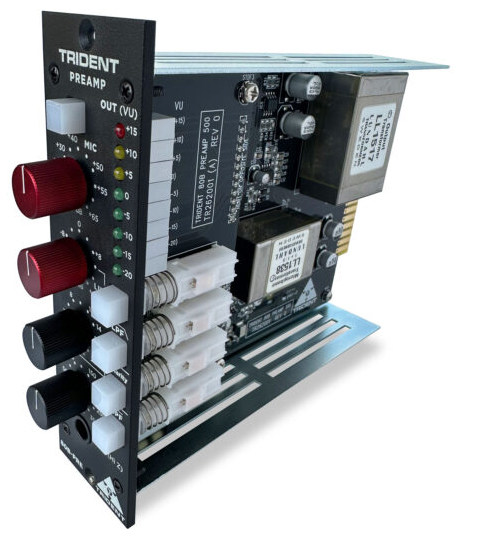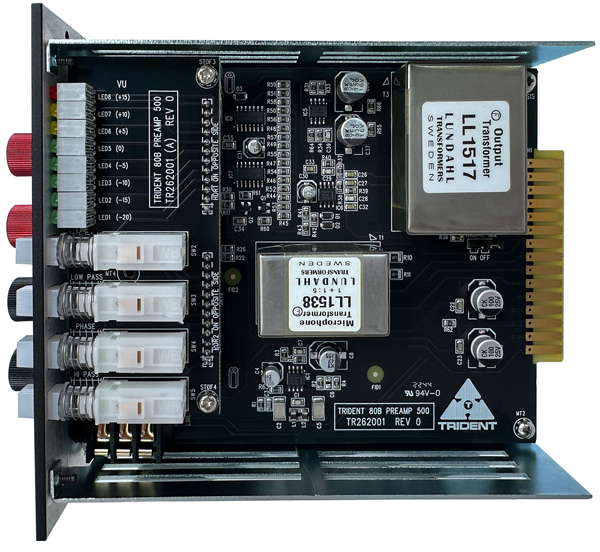
Barry's Mix Magazine Equipment And Software Reviews
Barry's Massive Discography And Engineering Career
Barry's Music Connection Magazine Reviews
Barry's Resolution Magazine Reviews
Trident Audio Developments Series 80B 500 Pre-amp
Low Cost Module Delivers Classic '70s Rock 'n' Roll Sound
By Barry Rudolph
 |
| Trident 80B 500 Pre-Amp |
 |
| Trident 80B 500 |
The Trident 80B 500 Series Microphone pre-amp has both Line and Mic inputs and runs Class-AB. It uses a Lundahl--LL1538 mic input transformer plus an electronically balanced line input available using a front panel 1/4-inch TRS jack. The Line input impedance is specified at 1-megohm making it perfect for direct guitars, basses, electronic keyboards and synths.
Gain for the microphone input is specified at: -10dB to +65dB while the Hi-Z Line input has a range of -20dB to +20dB. Another Lundahl LL1517 transformer is used for the output for a maximum of +27dBu driving 600-ohm impedances.
Back in the day, Trident used Belclere transformers in the original design and it turns out that Trident's designer Taz Bhogal says that the Lundahl transformers' design make them the closest fit to retain all the characteristics of the classic Trident 80B sound. And that sound differs significantly from the sound of the Trident A-Range that runs Class-A and uses Ed Reichenbach's --Jensen JT-13K transformers.Inputs, Knobs, and Buttons
Because of the dual inputs, the 80B can handle a wide range of signal levels--anywhere from -60dBu (XLR Mic input) to as high as +24dBu (Line input) without an attenuator (pad) switch. There are separate Gain controls for both the low impedance (150-ohm) mic input and the high-impedance line input.
A Line switch toggles between the two inputs so you are able to maintain separate settings for recording both an XLR mic and a direct instrument. I liked the "calibration" mark on the front panel by the Line level input control knob that represents a standardized setting. There is also a detent at 0dB on the Line control (straight up at 12noon) for recalls and/or returning to a standard operating level. I loved that all the Trident 500 modules retained the aluminum control knobs from the original consoles.
Besides the Line input changeover switch, the front panel also has lighted buttons for flipping output Polarity, 48-volt phantom on/off, and switches for both the continuously variable 30Hz to 350Hz Low Pass and 2kHz to 20kHz High Pass filters. Both filters are available for both mic and line input sources.
I found these 12dB/octave (2nd order) filters perfectly suited to tracking any source in the studio from close-miked acoustic guitars to lead vocals to drum overhead mics. The front panel finishes with an Output VU meter using eight colored LEDs to measure output levels from -20dB to +15dB.
In The Studio
For this review I received two Trident 80B 500 Series Microphone pre-amps and I installed them into my Fix Audio Bucket 500 Rack. The full-sized square buttons and the bright, focused VU meter LEDs are easy to see and verify from across my control room.
 |
| Trident 80B 500 Pre-Amp |
I started by recording a new Fuchs Clean Machine II guitar amp plugged into a 30-watt, 12-inch Hellatone speaker in an Avatar open-back cabinet. I also tried the same amp driving a Two-Rock Speaker Cab. I used tried both a Shure MV-7 dynamic mic and Mojave MA-D microphones and my usual locations on and around the speaker cone.
Here, slight changes in the mic positioning were easy to discern--as it should be--even with loud guitar sounds.
The front panel markings on the 80B pre-amp matched my other pre-amps with the same 30-40dB of gain usually required for close-miked, loud guitar amps and typical dynamic microphones. The 80B was very clear sounding realistically picking up the increased headroom of this boutique guitar amp's dynamics. I grew to appreciate the continuously variable High-Pass filter on the 80B for reigning in low frequency bumps and high frequency harshness when required. Adjustable HPF and LPF filters are usually only on console channel strips.
Vocals also went very well with the Trident 80B. I have a Trident Decca-Dent 500 rack mounted at the top of my outboard cabinets so I can adjust them immediately. Depending on the singer, sometimes I will do some old school gain "riding" while in record and the continuously variable gain control makes that easy.
Because of the 80B's semi-parametric filter control knobs, there is no room for an Output level control on the front panel of the 80B and I do wish the mic gain control knob had detents to add a "feel" for this process. Having said that, the precise Mic Gain control and the 80B's inherent dynamic range and low noise floor makes gain riding less necessary to still sound transparent.
I put up a Soundelux Bock U195 Condenser Microphone cardioid condenser (normal mode, no lo cut) and my singer positioned about 8 to 10-inches away. I used around 50dB of gain that gave me plenty of level going into a Retro Instruments' 176 Limiting Amplifier.
The Trident 80B sounded great and the filters were very gentle in their effect(s) with the HPF just great for singers set at 50Hz or lower or acoustic guitars set to 50 to 150Hz depending on the mic used, it's distance, and the guitar's body size. The LPF did work well on recording cymbals and hi-hats but for me anyway, that is usually mix decision.
Trident Audio Developments 80B 500 Pre-Amp sounds great and took me back to the times of my youth using Trident consoles. It's all there!
|
|
|
|
|